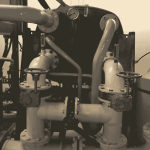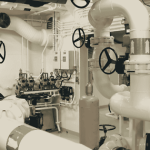Fresh water is one of the most essential aspects of routine operations for ships and its crew when at the sea. Fresh water is taken from port facilities and also generated on board ships.
Dedicated tanks are provided on ships to store this fresh water. However, fresh water can easily get contaminated in several ways and proper steps should be taken to prevent the same .

In this article, we will take a look at various steps that should be taken to prevent contamination of freshwater on board ships.
When fresh water is taken from barges or ports, it should be noted that dedicated hoses are used for the transfer purpose. Having said that every possible step should be taken to ensure that the fresh water is not contaminated during the transfer process or in the fresh water tanks.
Fresh water in the tanks should be treated with chlorine at regular intervals of time; however, it should be noted that the fresh water taken from the shore has residual chlorine content of 0.2 PPM.
Fresh water generated using desalination plants (fresh water generator) or reverse osmosis process on ships should be transferred to the fresh water tanks only when the ship is 25 miles away from the shore or 50 miles from an estuary.
Several methods are used to sterilize water on ships. If ultra violet sterilizer and automatic chlorinator system are used, they should be in proper working condition. Moreover, a full flow silver ion system can also be used for the same.
Fresh water storage tanks should be prevented from getting contaminated by taking every step possible. The following steps must be taken without fail.
· If possible, drinking and washing water should be kept in a separate tank, which is isolated from the system supplying fresh water to jacket water, oil purifiers etc. In case such arrangement is not possible, a non return valve or an air break in the pipe work should be fitted to prevent any back contamination.
· Fresh water storage tanks should be inspected at regular intervals of time and proper maintenance should also be carried out. They must be inspected every 12 months and refilled with sterilized water following cleaning with a 50 PPM chlorine solution.
· Fresh water tanks should not be located near any of the oil tanks
· Fore peak tanks which are susceptible to damage, or aft peak tanks which are too difficult to clean should not be used for fresh water storage
- The storage tanks should be designed in such a way that easy drainage and cleaning is possible.
- Tanks should be pressure tested every 10 years to ensure that there is no seepage of any kind.
- Manholes should be made of adequate size and must be raised above the deck level
- Pipes which have the same quality of water should be allowed to pass through the tanks
- Goose necks should be properly designed to prevent ingress of sea water
- Proper coatings as suggested by the manufacturers should be applied inside the tanks
- Contamination of fresh water mainly occurs in the distribution system and therefore suitable filtration system (filters and strainers) is a must.
- Water treatment equipment, neutralizers, softeners etc. should also be used to improve the quality of water.
- Hot water line in the fresh water generator should be properly insulated especially when it runs adjacent to the cold water line. Moreover, special care should be taken while choosing material used for the joints.
- The fresh water distribution system should be a part of the planned maintenance system on ships.
- Chlorinators should be raised to 70oC before opening for inspection to kill any type of bacteria colonies. Moreover, opportunity should be taken at refits to flush the system with 50 PPM chlorine solution. Shower heads and taps should be cleaned in a similar solution every 3 months.
- Chemicals approved and suggested by the manufactures must only be used to prevent any kind of toxicity entering the fresh water.
- Antifouling equipment of the approved type should be used if required.


